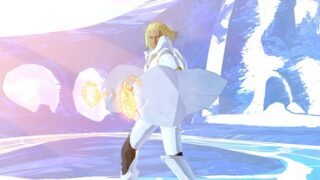
Since it was first announced, El Shaddai: Ascension of the Metatron has been high on my radar. It tells the tale of Enoch, a priest in Heaven, who must find and purify the seven fallen angels in order to prevent God from flooding the Earth. Lucifel, God’s top angel, shows you the way, introducing you to God’s weapons and reporting your progress to the big guy himself. Luckily, these angels have assembled a tower where they all rule, making it Enoch’s job to climb its floors and deal with each angel one-by-one. The story is loosely based on the non-canonical Jewish religious text, the Book of Enoch.
I have a love/hate relationship with El Shaddai.
The game’s strikingly-beautiful design is one of the bits I love. It takes a bold new approach with aesthetic, and makes each stage truly a sight to see. Each of the game’s eleven chapters does something new with the visuals; one chapter could look like a watercolor painting, while the next could be a TRON-esque futuristic city. The visual experience of El Shaddai is so important that the developers turned off the heads-up display (the on-screen gauges) so that there is nothing to distract you from enjoying the game’s beautiful creative (you can enable the HUD after your first play-through). Screenshots don’t do the game much justice, but:
It’s really something you have to see in motion to fully enjoy.
But as pretty as they are, visuals are just that: visuals. They say you shouldn’t judge a book by its cover, after all. And while El Shaddai‘s appears to be one of the most wondrous and innovative in recent years, there is nothing the game does that is very new at all. In fact, its action–adventure-type gameplay feels relatively downgraded from what you might experience in other games of the same genre. Its combat system is odd. There is one attack button and another to defend. Depending on the timing of your button presses, you can pull off different combinations of moves, but there aren’t very many. Most of the time, you’ll find yourself repetitively performing the same attacks.
You have access to three weapons in El Shaddai, but you can only hold one at a time. The Arch is your blade, best used for short-range combat. When jumping, you’re able to slowly float to the ground. The Gale is your long-range weapon, which allows you to shoot projectiles at the enemy from afar. It also allows you to perform a shock wave-esque quick dash. The Veil is your heavy-duty weapon. It’s essentially two big boxing gloves. In times of defense, it can become a shield that blocks nearly any attack. In battle, you can steal other weapons from enemies and purify them for Enoch’s use. After a number of hits with the weapon, you must purify it once again, as striking the enemy slowly infects the weapon with vileness. Both Enoch and enemies’ health are determined by their physical appearance. Enoch’s armor will break bit-by-bit as he’s attacked.
You get all three weapons nearly at the start of the game, so from the get-go there’s never really much to gain. You’ll collect these red orbs, which you can obtain from destroying certain objects, but they serve no purpose. I must’ve destroyed every object and collected every red orb I found, but their use was never displayed. Enoch’s abilities always remained the same—there are no character upgrades or anything of the sort. Though, when you beat the game, you can unlock additional outfits for Enoch.
The majority of my playthrough felt like a big mesh of boring. I was fighting the same enemies, using the same weapons and attacks, and traversing the same platforming elements. The game is pretty much a ‘run through stage, fight, run through stage some more’-type game, presenting very little puzzles or brain-teasers along the way. There are plenty of 2D side-scrolling levels, as well, but they feel as if they’re tossed in so that everything doesn’t appear too repetitive.
When you’re given everything at the start and presented with so little variation in anything besides the look of the level, the game gets old fast. Even if you’re just playing for the story, it’s very poorly told. Most of the time, I had no idea what was going on until after I’d beaten the stage, when Lucifel kindly summarizes its events. Without him, none of El Shaddai‘s happenings would really make any sense.
I said I have a love/hate relationship with this game, but there are really only two things I love. The gameplay design is one of them. The other is the boss fights. If there’s anything that makes traversing each stage worth it, it’s the baddie waiting at the end. Unlike standard combat, where fighting enemies feel more like a chore than it does fun, boss fights apply strategy and are usually exciting and lively. You’re able to switch between all three weapons during boss fights, choosing the best weapon for the occasion. Some bosses have various transformations where only a certain weapon can affect them. Learning their pattern, using the right weapon, and knowing when to strike makes them battles worth fighting.
El Shaddai is an unusual release. It has visual appeal, but is a failed attempt at something great. I had high hopes for El Shaddai and believed it had great potential, but the final product didn’t satisfy. If it’s for a look at something nice and a few fun boss fights, then El Shaddai‘s for you. Otherwise, we suggest you stay away. Simply put—for the most part, at least—the game just isn’t fun.
4/10
El Shaddai: Ascension of the Metatron was reviewed on a PlayStation 3. Story mode was played to completion (11 hours). El Shaddai: Ascension of the Metatron launches for PlayStation 3 and Xbox 360 on August 16, 2011 for an MSRP of $59.99.

